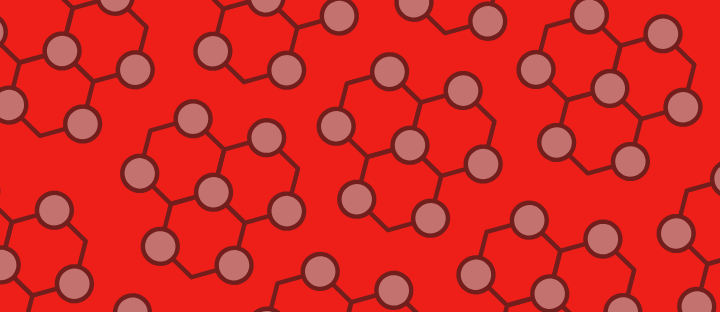What are small molecule drugs? Where do they come from? How do they work? This blog post and accompanying video was created by a team of biotechnology students at Columbia University as part of a class project for the Seminar in Biotechnology taught by Dr. Lili Yamasaki. Thank you to Yanzhe Ma, Yishu Yin, Jerry Shen, Alex Jin, and Wanyun Li for volunteering your time and expertise to create this Research Simplified resource for the KIF1A.ORG community!
With advances in biomedical science, there are new, innovative therapeutic treatments emerging now and then. Still, small molecule drugs dominate the pharmaceutical market. Between 2007 and 2016, 77% of FDA-approved new drugs are small molecule drugs, and 23% of these new drugs are biologics drugs [1].
What exactly are small molecule drugs? Small molecule drugs are pharmaceutical, chemical compounds under 1000 Daltons molecule weight. Just like we use grams to measure the mass of objects like paperclips or sugar, a Dalton is a unit of mass that helps us measure even smaller objects like molecules. Keep in mind, the average mass of one molecule of water is about 18 Daltons. You would need just 56 water molecules to exceed the upper limits of the weight of a small molecule (See Figure 1 below). So, the small molecule drugs are very small. Because of their tiny size, small molecule drugs can pass through cell membranes and reach their targets. Another feature of small molecule drugs is these drugs can be chemically synthesized in a laboratory.
In contrast, biologic drugs are isolated from living organisms, including humans, animals, and microorganisms [2]. One of the distinguished advantages of small molecule drugs is their manipulable distribution methods and how they work [3]. Usually, the small molecule drugs are administered orally, providing convenience and relatively low costs.

As mentioned earlier, small molecule drugs can get into cells due to their tiny weight. Once they enter the cell, these drugs interact with various proteins in different ways. The most common targets for small molecule drugs are receptors and enzymes. Receptors are like sentinels for the cell. They receive messages from other cells or environments and inform the cell they reside in what to produce or not to produce. Enzymes are catalysts that speed up the production inside cells. The production has to happen fast enough to support life. As a result, the small molecule drugs can stimulate the wanted molecular pathways—a series of actions among molecules in a cell that leads to a certain endpoint or cell function [4]—and suppress the unwanted molecular pathways by engaging their biological targets.


(a) shows how small molecules could regulate the enzyme activity;
(b) shows how small molecules could facilitate or block signal transduction.
Broadly speaking, small molecule drugs can inhibit the disease onset and alleviate the symptoms of diseases. But still, small molecule drugs have their limitations. These drugs do not have regenerative ability. Specifically, they cannot restore the normal function of cells, tissues, or organs.
Aspirin, one of the common over-the-counter medications, is an example of a small molecule drug (see Figure 3). The drug was first approved by FDA in 1965 and is commonly used as a pain reliever (analgesics) [5]. Aspirin is weighted around 180 Daltons [5]. The structure of the aspirin is illustrated below. Once aspirin enters the body, it can target enzymes called cyclooxygenase enzyme 1(COX 1) and cyclooxygenase enzyme 2 (COX 2) [5]. These enzymes are responsible for the synthesis of prostaglandins which cause inflammation and pain [5]. Aspirin, however, suppresses the cyclooxygenase enzyme pathway by targeting COX1 and COX2 enzymes. As a result, aspirin inhibits the production of prostaglandins. Voilà! The pain is gone.

Questions? Leave a comment or send an email to impact@kif1a.org!
All figures were created with BioRender.com
References:
- Beall, R.F., Hwang, T.J. & Kesselheim, A.S. Pre-market development times for biologic versus small-molecule drugs. Nat Biotechnol 37, 708–711 (2019). https://doi.org/10.1038/s41587-019-0175-2
- “What Are ‘Biologics’ Questions and Answers,” FDA. https://www.fda.gov/about-fda/center-biologics-evaluation-and-research-cber/what-are-biologics-questions-and-answers
- “A big future for small molecules: targeting the undruggable,” AstraZeneca. https://www.astrazeneca.com/r-d/next-generation-therapeutics/small-molecule.html
- NCI dictionary of Cancer TERMS. (n.d.). Retrieved March 09, 2021, from https://www.cancer.gov/publications/dictionaries/cancer-terms/def/molecular-pathway
- National Center for Biotechnology Information (2021). PubChem Compound Summary for CID 2244, Aspirin. Retrieved February 21, 2021, from
https://pubchem.ncbi.nlm.nih.gov/compound/Aspirin.


[…] Small Molecule Drugs 101 […]
[…] Learn More Here […]
[…] a previous blog post, we introduced what small molecules drugs are. A common follow-up question is what small molecule […]